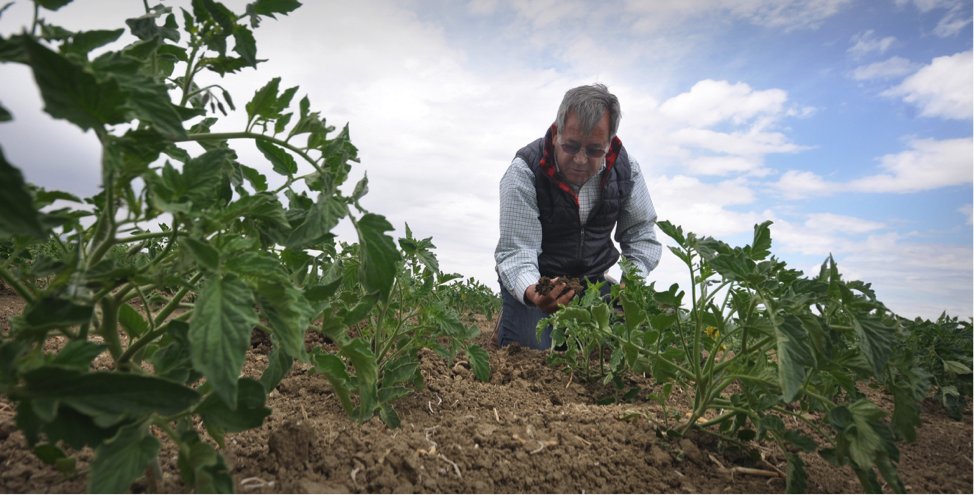By Anita Brown, NRCS Public Affairs Director
How do you cut your water use by a third, cut your nitrogen (N) use in half, maintain your tomato yield and improve your fruit quality?
“With patience, perseverance and by treating your soil like a living ecosystem — which it is,” says Jesse Sanchez.
Sanchez should know. He and Alan Sano have been experimenting with soil enhancements for 15 years on Sano Farms in Firebaugh, Calif. They believe they have hit upon a winning strategy, though their experiments continue.
Today, they grow 50 ton-per-acre tomatoes with half of the N (120 units) and a third less water than before. They also report fewer weeds and better tomato quality.
The soil organic matter — the living portion of the soil that turns crop residue into minerals needed by growing plants — has gone from 0.5% to 3%, report Sano and Sanchez.
“The soil is like day and night. You can dig it with your hands,” Sanchez says, cupping a handful to prove his point.
So how do you transition largely inert soil into the ecological powerhouse found on Sano Farms?
Cover crops, reduced equipment passes and subsurface irrigation have been key, according to UC Davis researcher Jeff Mitchell. These practices combine to feed and protect the soil microorganisms often ignored in agricultural systems. Mitchell has been coaching the Sano/Sanchez team for over 10 years, witnessing their progress and connecting them with like-minded farmers and organizations.
“Farmers sometimes worry that cover crops will compete with the cash crop for water and nutrients,” Mitchell says. “We’re starting to see at Sano Farms — looking long term— that the tradeoffs might actually be favorable.”
Sanchez says he terminates the cover crop before the tomatoes are planted, leaving the dead residue to smother weeds and feed the soil microorganisms.
The organic matter also builds the sponge that allows the farm to thrive on less water, says Zahangir Kabir, soil health specialist with USDA-NRCS.
“A 1% increase in soil organic matter builds your soil’s ability to hold water by 19,000 to 25,000 gallons per acre,” he explains. “Thus, calculating conservatively, Sano Farms’ fields hold 50,000 gallons of water more per acre than they did before.”
You can see this in action at Sano farms.
“When it rains here, the water soaks into the field. It stays put,” Sanchez says. “It doesn’t run off like some farms.”
Sanchez, who received a White House Champions of Change Award last summer, says he knows farmers resist change.
“But we can’t stop change,” he says. “It’s all around us.”
And, if farmers do change the way they work with their soil, “they are going to like what they see. ”
Sanchez will be a featured speaker at the second annual Latino Farmers Conference taking place on Nov. 15 at the Monterey Hyatt Regency. The event is free but registration is required.
Click here to watch a video Alan Sano and Jesse Sanchez at Sano Farms in Firebaugh.






